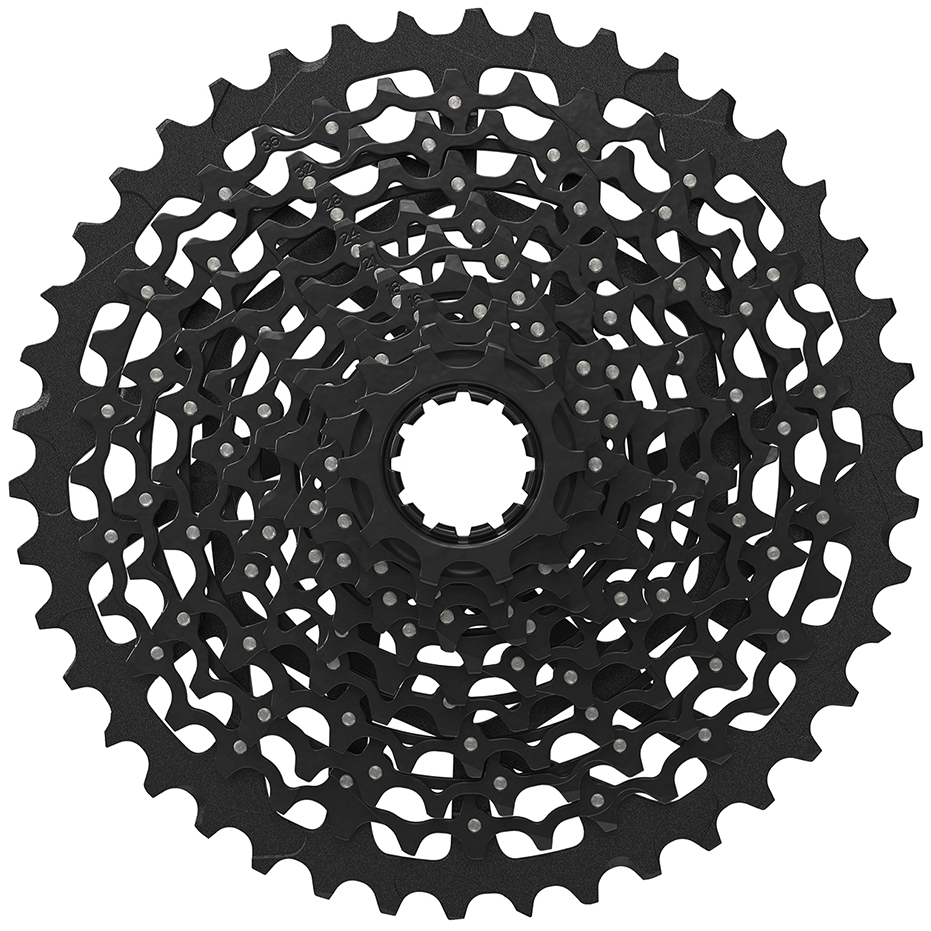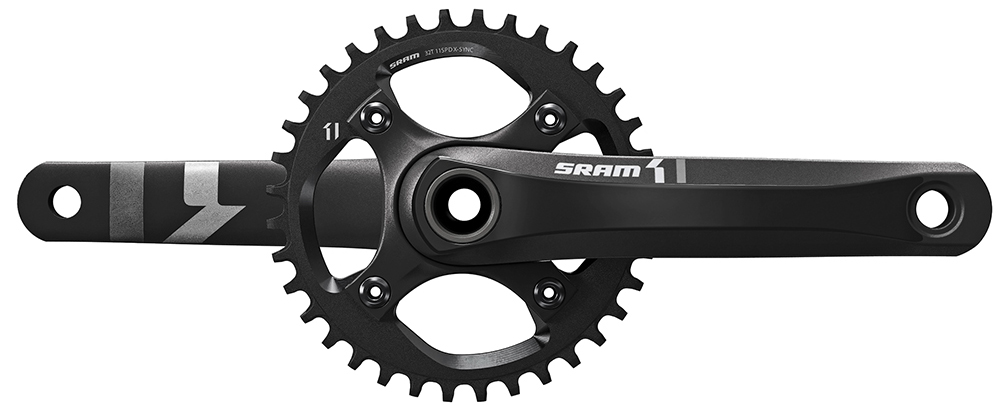The Cassette

The X1 cassette is also notably different from that of the X01 and XX1 kits. The X01 and XX1 utilize SRAM’s “X-Dome” construction, which basically means the bottom 10 gears of the cassette are machined out of a solid chunk of steel, and the the aluminum 42 tooth cog is pinned on to this group. All this means that the XX1 / X01 X-Dome cassettes are (1) impressively light, (2) impressively expensive, and (3) the process of making them is really cool. The X-Dome method of construction also makes for a good, open design, which does help a bit in shedding mud and keeping things running cleanly.
The X1 cassette is made with essentially a scaled back version of the X-Dome process. Only the bottom 3 cogs are machined from the same piece of steel (SRAM calls it “Mini Cluster” construction). From there, 7 remaining steel cogs are pinned together with the final 42-tooth cog as the backbone of the cassette. As far as I can tell, the X1’s 42t aluminum cog is identical to that found on the X01 cassette.
Despite the slight differences in construction from the XX1 cassette, the X1 cassette still maintains a nice open design and stays clean well. It’s just a little heavier than the X01 and XX1 options, but it’s functionality is till solid. In theory, the XX1 / X01’s X-Dome construction is a bit stiffer than the pinned design on the X1, but at my weight of 150 lbs., I can’t tell any difference.
The Cranks and Chainring
The X1 cranks that I tested were the 1400 Hollow Forged X-Sync cranks. SRAM makes two other levels of cranks for the X1 line: the 1200, which is OEM only and can’t be purchased aftermarket, and the 1000, which is a bit less expensive and a bit heavier than the 1400. Since I haven’t played with the 1200 or 1000, this discussion will just look at the 1400.

While The X1’s cranks are made out of hollow aluminum, while the X01’s and XX1’s are made with carbon. The other primary difference is that the X1 cranks use a different bolt circle diameter than the XX1’s. For those that aren’t familiar, the bolt circle diameter (bcd) is the diameter of the circle formed by the bolts that hold the chainring on. Traditional 10-speed cranks usually use a 104mm bcd. This number is important for single ring setups because, with a 104mm bcd, at 32 tooth chainring is the smallest you can typically run (though a couple companies, like Wolftooth, make smaller, more compatible options).
When you have more than one chainring up front, this isn’t really an issue – a normal 2×10 setup would use a 36t ring. But with an 11-speed setup with a single chainring, some people will want to use a ring that’s smaller than 32t, and that 104mm bcd becomes problematic.
This is where SRAM’s various crank options come into play. The X1 cranks have a 94mm bcd, which means that you can go down to a 30t chainring. The X01 cranks also have a 94mm bcd, but the XX1 cranks go down to a 76mm bcd, which allows you to run a 28t chainring. This means two things: (1) SRAM cranks don’t use a “standard” 104mm bcd chainring mount, so your options for chainrings are somewhat limited, and (2) if you want an 11-speed setup and you really need that super easy gear, the XX1 cranks are your best bet.
Before I wade into a discussion of the X1 1400 cranks that I tested, I should note that I didn’t spend as much time on them as I would have liked. I was using the GXP version of the cranks, which works with a traditional threaded bottom bracket shell (the X1 cranks are also available for BB30 frames).
I installed the group on my Canfield Yelli Screamy, which has a 73mm bottom bracket shell. As I noted in my review of that frame, my 32t chainring mounted on Shimano XT cranks barely cleared the chainstays, and I had to mess around with the bottom bracket spacers to make it fit.

The X1 cranks unfortunately didn’t fit on my Yelli, and no amount of messing with bottom bracket spacers would get the chainring to clear the chainstay. The cranks are also made in a way that the chainring cannot be moved to the outside of the mounting tabs; there’s only one position in which the ring can be mounted. To be clear, I blame this little conundrum on the frame. The Yelli has burly, widely spaced stays, and while the stays are great for stiffness and tire clearance, they’re horrible for fitting chainrings. If your frame is tight on chainstay clearance, you might run into similar problems fitting the X1 cranks.
So, for most of my testing, I was using Shimano XT cranks with a 32t e13 narrow/wide guide ring. I won’t bother going into any details with that setup, but I didn’t have any problems with it and it worked well with the rest of the X1 kit.
I ended up installing the X1 cranks on a Pivot Firebird, because that’s the only other bike I had at my disposal that had a threaded bottom bracket. That installation went smoothly and easily – there was plenty of clearance for the chainring, and the cranks spun nice and smoothly. The cranks use a fairly standard 2-piece setup; the BB spindle is attached to the drive side crank arm, and the non-drive side attaches via a splined fitting and a single bolt into the spindle. Like most cranks available these days, removal just involves unscrewing that bolt.
In terms of performance, the X1’s narrow/wide chainring held the chain without any problems, and I didn’t notice anything that raised any red flags about the cranks. I’m not a huge guy and I didn’t notice a huge difference in stiffness between the X1’s cranks and the XX1’s—they weren’t noticeably flexy by any means.
The chainring on the X1 cranks has the same tooth profile as the rest of the SRAM chainrings, which seems to be a good thing. The chainring teeth are a bit broader than the teeth on my e13 Guide Ring, and they seem to have a slightly better grasp on the chain. (Click here to read more about the e13 ring, along with some e13 cranks). However, I haven’t had any significant problems with dropping the chain either on the SRAM chainring or on my e13 ring without any sort of chainguide.
It’s worth noting that the X1 cranks don’t come with any sort of bashguard installed. I don’t generally run a bashguard, so this doesn’t really bother me, but if you’re prone to smashing your chainring into things, you’ll need to find a bashguard that works with the 94mm bcd on the X1 cranks. According to SRAM’s website, a “chain ring guard” is available for these cranks, and you could also look into a taco-type bashguard like the MRP XCG.
The Chain
I don’t have too much to report about the X1 chain; I haven’t broken it, and it seems to shift nicely. It uses solid pins, while the X01 and XX1 kits both use the same hollow pin chain with a different finish that, supposedly, makes it last longer. I’ll report back if the X1 chain has any durability issues in the months of riding ahead.

The chain is installed via a master link, similar to that used on SRAM’s 10-speed chains, but the 11-speed master link isn’t re-usable. It can be removed, and you’ll probably need some pliers to get it off, but once it’s off, you have to replace it. The same goes for both the X01 and XX1 chains.

Late comment on a good article, but I’m wondering if you ever ran into any rattling from your X1 derailleur? Mine has started after about 9 months, and is turning out to be really hard to pin down. For reference, it happens mostly when coasting — but not always — over sharp edged bumps, and sounds a lot like the rattling that the TA capture nut can make in a Fox fork when there is no axle installed, and you tap the fork. BB in a boxcar kind of thing.
Thanks for all the great reviews, Noah, even when I don’t agree with you, the insight is always interesting!
Hey Tom – my X1 is still going strong and rattle free. Just from what you described. If the elusive noise is actually in the derailleur and since it’s happening while coasting, it seems that it’d have to be in the clutch mechanism. Those clutches are somewhat known for making a bit of noise from time to time, although I’ve always experienced it as more of a “clunk” and less of a “rattle.”
If you’re fairly certain the noise is coming from the derailleur, you could take a stab at rebuilding the clutch. I don’t have any first hand experience in this ballpark, but based on tutorials like this one, it seems pretty straight forward:
http://bicyclingaustralia.com.au/2013/08/sram-type-2-overhaul
Hope you can get that sorted!
-Noah
SRAM X1 derailleur are the best choice for us that aren’t sponsored. I say that because last week I broke my X01 rear derailleur on a small rock (rock going between rays). The broken part is the carbon outer cage, and for my surprise, SRAM don’t make this piece was service part! Believe or not, if you broke you carbon outer cage (XX1 ou X01) you will need a new one. This is a poor service from SRAM.
(Data from SRAM Spare Parts Catalog 2016 • Rev A, pag 55)